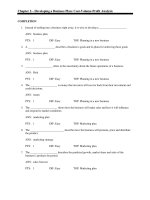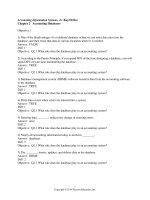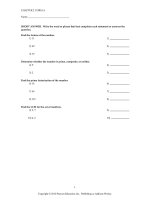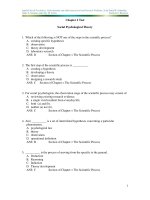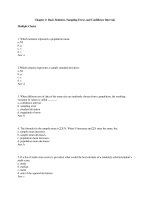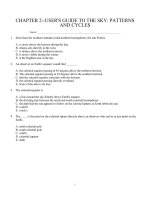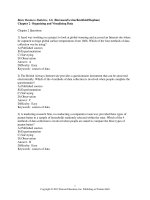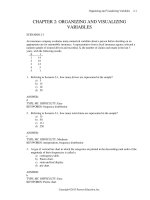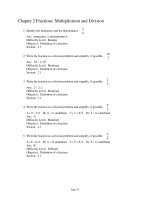Business statistics 2nd edition sharpe test bank
Bạn đang xem bản rút gọn của tài liệu. Xem và tải ngay bản đầy đủ của tài liệu tại đây (64.15 KB, 12 trang )
CHAPTER 2 Quiz A Business Statistics, 2nd ed.
Business Statistics: Chapter 2: Data – Quiz A
2-1
Name_________________________
1. The mission of the Pew Internet & Life Project is to “explore the impact of the
Internet on families, communities, work, home, and daily life.” In August – September
2007 they conducted telephone interviews with a sample of American adults aged 18 and
older about online shopping. Describe the W’s for the information given.
•
•
•
•
•
•
Who:
What:
When:
Where:
How:
Why:
2. The following table displays some of the data collected in the Pew Internet & Life
Project about online shopping. List the variables in the data set. Indicate whether each
variable is categorical or quantitative. If the variable is quantitative, give the units.
Age
Gender
Household
Income
Participated in
online auction?
25
47
38
30
Male
Female
Female
Male
$55,000
$60,000
$110,000
$62,000
Yes
No
No
No
Monthly
amount spent
online
$250
$50
$120
$75
Time (hours) per week
browsing online
retailers
6
4
10
4
3. In addition to the variables listed above, data were also collected on the variables
listed below. Indicate whether each is nominal or ordinal.
•
•
•
Region (Urban, Suburban, Rural)
Education (Less than High School, High School, Some College, College +)
Marital Status (Single, Widowed, Divorced, Married)
4. For each of the following, indicate whether the data are cross-sectional or time series:
•
•
•
Weekly receipts at a clothing boutique
Monthly demand for an automotive part
Percentage of adults who bank online
Copyright © 2012 Pearson Education, Inc. Publishing as Addison-Wesley.
2-2
CHAPTER 2 Quiz A Business Statistics, 2nd ed.
Business Statistics: Chapter 2: Data – Quiz A – Key
1. The mission of the Pew Internet & Life Project is to “explore the impact of the
Internet on families, communities, work, home, and daily life.” In August – September
2007 they conducted telephone interviews with a sample of American adults aged 18 and
older about online shopping. Describe the W’s for the information given.
• Who:
American adults aged 18 and older
• What:
online shopping
• When:
August – September 2007
• Where:
United States
• How:
telephone interviews
• Why:
to explore the impact of the Internet on daily life, specifically shopping
2. The following table displays some of the data collected in the Pew Internet & Life
Project about online shopping. List the variables in the data set. Indicate whether each
variable is categorical or quantitative. If the variable is quantitative, give the units.
Age
Gender
Household
Income
Participated in
online auction?
25
47
38
30
Male
Female
Female
Male
$55,000
$60,000
$110,000
$62,000
Yes
No
No
No
Monthly
amount spent
online
$250
$50
$120
$75
Time (hours) per week
browsing online
retailers
6
4
10
4
Categorical: Gender, Participated in online auction?
Quantitative: Age (years), Household Income ($), Monthly online spending ($),
Browsing time per week (hours).
3. In addition to the variables listed above, data were also collected on the variables
listed below. Indicate whether each is nominal or ordinal.
• Region (Urban, Suburban, Rural)
Nominal
Copyright © 2012 Pearson Education, Inc. Publishing as Addison-Wesley.
CHAPTER 2 Quiz A Business Statistics, 2nd ed.
2-3
• Education (Less than High School, High School, Some College, College +)
Ordinal
• Marital Status (Single, Widowed, Divorced, Married)
Nominal
4. For each of the following, indicate whether the data are cross-sectional or time series:
• Weekly receipts at a clothing boutique
Time Series
• Monthly demand for an automotive part
Time Series
• Percentage of adults who bank online
Cross-Sectional
Copyright © 2012 Pearson Education, Inc. Publishing as Addison-Wesley.
2-4
CHAPTER 2 Quiz B Business Statistics, 2nd ed.
Business Statistics: Chapter 2: Data – Quiz B
Name_________________________
1. Consumer Reports Health routinely compares drugs in terms of effectiveness and
safety. In summer 2008 they reviewed drugs used to treat arthritis. Information was
reported on convenience of use (how many pills required each day), possible side effects
(e.g., dizziness, stomach upset), cost, and ratings of effectiveness in relieving symptoms
(very effective, somewhat effective, not effective). Describe the W’s for the information
given.
•
•
•
•
•
•
Who:
What:
When:
Where:
How:
Why:
2. List the variables reported in the Consumer Reports Health article on drugs used to
treat arthritis. If the variable is quantitative, give the units. If the variable is categorical,
indicate whether it is nominal or ordinal.
3. The Human Resources Department of a large corporation maintains records on its
employees. The table displays some of these data. List the variables in the data set.
Indicate whether each variable is categorical or quantitative. If the variable is
quantitative, give the units. If the variable is categorical, indicate whether it is nominal or
ordinal.
Age
32
52
60
28
Employment
Category
Clerical
Professional
Professional
Clerical
Education
High School
College
Junior College
High School
Participates in
Paycheck Benefit
Wellness Program? Deductions
Yes
$250
No
$120
Yes
$0
No
$120
4. For each of the following, indicate whether the data are cross-sectional or time series:
•
•
•
Company quarterly profits
Percentage of American adults who work full time
Historical closing stock prices
Copyright © 2012 Pearson Education, Inc. Publishing as Addison-Wesley.
CHAPTER 2 Quiz B Business Statistics, 2nd ed 2-5
Business Statistics: Chapter 2: Data – Quiz B – Key
1. Consumer Reports Health routinely compares drugs in terms of effectiveness and
safety. In summer 2008 they reviewed drugs used to treat arthritis. Information was
reported on convenience of use (how many pills required each day), possible side effects
(e.g., dizziness, stomach upset), cost, and ratings of effectiveness in relieving symptoms
(very effective, somewhat effective, not effective). Describe the W’s for the information
given.
• Who:
drugs to treat arthritis currently on the market
• What:
convenience of use, side effects, cost, effectiveness ratings
• When:
summer 2008
• Where:
not specified, probably United States
• How:
testing on drugs
• Why:
information for potential consumers/patients
2. List the variables reported in the Consumer Reports Health article on drugs used to
treat arthritis. If the variable is quantitative, give the units. If the variable is categorical,
indicate whether it is nominal or ordinal.
Categorical: Side effect (nominal), effectiveness rating (ordinal)
Quantitative: Convenience of use (number of pills), Cost ($)
3. The Human Resources Department of a large corporation maintains records on its
employees. The table displays some of these data. List the variables in the data set.
Indicate whether each variable is categorical or quantitative. If the variable is
quantitative, give the units. If the variable is categorical, indicate whether it is nominal or
ordinal.
Copyright © 2012 Pearson Education, Inc. Publishing as Addison-Wesley.
2-6
CHAPTER 2 Quiz B Business Statistics, 2nd ed.
Age
32
52
60
28
Employment
Category
Clerical
Professional
Professional
Clerical
Education
High School
College
Junior College
High School
Participates in
Paycheck Benefit
Wellness Program? Deductions
Yes
$250
No
$120
Yes
$0
No
$120
Categorical: Employment Category (nominal), Education (ordinal), Participation in
Wellness Program? (nominal)
Quantitative: Age (years), Paycheck Benefit Deductions ($)
4. For each of the following, indicate whether the data are cross-sectional or time series:
• Company quarterly profits
Time Series
• Percentage of American adults who work full time
Cross-Sectional
• Historical closing stock prices
Time Series
Copyright © 2012 Pearson Education, Inc. Publishing as Addison-Wesley.
CHAPTER 2 Quiz C Business Statistics, 2nd ed.
Business Statistics: Chapter 2: Multiple Choice Quiz C
Name___________________
2.1. Provide context for data.
1. In the fall of 2007, the Pew Internet & Life Project conducted telephone interviews
with a sample of American adults aged 18 and older about online shopping. American
adults aged 18 and older constitute the ______ of the study.
A.
B.
C.
D.
E.
Who
What
When
Where
How
2.2. Identify cases, variables and any units.
2. A few of the variables for which data were collected in the Pew Internet & Life
Project study about online shopping include age, gender, income, and number of hours
spent shopping online per month. Which of the variables is categorical?
A.
B.
C.
D.
E.
Age
Gender
Income
Number of hours spent shopping online
None
2.2. Identify cases, variables and any units.
3. The Pew Internet & Life Project study about online shopping asked respondents to
indicate their education level on the following scale: Less than High School, High
School, Some College, College +. Which of the following statements is (are) true?
A.
B.
C.
D.
E.
2-7
Education level is a categorical variable.
Education level is nominal scaled.
Education level is ordinal scaled.
Both A and B
Both A and C
2.1. Provide context for data.
4. Consumer Reports Health routinely compares drugs in terms of effectiveness and
safety. In summer 2008 they reviewed drugs used to treat arthritis. Among the
information reported was convenience of use (how many pills required each day) and
possible side effects (e.g., dizziness, stomach upset). Convenience of use and possible
side effects constitute the ________ of the study.
A. Who
B. What
C. When
D. Where
E. How
Copyright © 2012 Pearson Education, Inc. Publishing as Addison-Wesley.
2-8
CHAPTER 2 Quiz C Business Statistics, 2nd ed.
2.1. Provide context for data.
5. What is the “Who” in a Consumer Reports Health study on the effectiveness and
safety of drugs used to treat arthritis?
A. drugs to treat arthritis currently on the market
B. convenience of use and possible side effects
C. summer 2008
D. the United States
E. testing on drugs
2.2. Identify cases, variables and any units.
6. A Consumer Reports Health study on the effectiveness and safety of arthritis drugs
collected data on possible side effects. This is what kind of variable?
A. Quantitative
B. Categorical
C. Nominal
D. Both A and C
E. Both B and C
2.2. Identify cases, variables and any units.
7. A Consumer Reports Health study on arthritis drugs takes into consideration cost.
Cost is
A.
B.
C.
D.
E.
is a nominal variable.
is a categorical variable.
is a quantitative variable.
is an ordinal variable.
is an irrelevant variable.
2.2. Identify cases, variables and any units.
8. The Human Resources Department of a large corporation maintains records on its
employees. Data are maintained of the following variables: Age, Employment Category,
Education, Whether or not the employee participates in a wellness program, and
Paycheck benefit deductions. Which of these variables are categorical?
A. Age, Employment Category, and Education
B. Employment Category, Education, and Whether or not the employee participates in
a wellness program
C. Education, Whether or not the employee participates in a wellness program, and
Paycheck benefit deductions
D. All of the variables
E. None of the variables
Copyright © 2012 Pearson Education, Inc. Publishing as Addison-Wesley.
CHAPTER 2 Quiz C Business Statistics, 2nd ed.
2.2. Identify time series and cross sections.
9. Which of the following is (are) based on cross sectional data?
A.
B.
C.
D.
E.
Company quarterly profits
Percentage of American adults who work full time
Historical closing stock prices
All of the above
None of the above.
2.2. Identify time series and cross sections.
10. Which of the following is (are) time series data?
A.
B.
C.
D.
E.
Weekly receipts at a clothing boutique
Monthly demand for an automotive part
Quarterly sales of automobiles
All of the above
None of the above
Business Statistics: Chapter 2: Multiple Choice Quiz C – Key
1. A
2. B
3. E
4. B
5. A
6. E
7. C
8. B
9. B
10. D
Copyright © 2012 Pearson Education, Inc. Publishing as Addison-Wesley.
2-9
2-10
CHAPTER 2 Quiz D Business Statistics, 2nd ed.
Business Statistics: Chapter 2: Multiple Choice Quiz D
Name___________________
2.1. Identify cases, variables and any units.
1. A university is interested in gauging student satisfaction in its online MBA program.
A survey is designed and administered via the Internet to a sample of students currently
active in the program. Which of the following would best describe the cases?
A.
B.
C.
D.
E.
Participants
Respondents
Experimental Units
Subjects
Variables
2.2. Identify cases, variables and any units.
2. In a survey undertaken by a university to gauge student satisfaction in its online MBA
program, one question asked students to indicate their employment status (unemployed,
employed part-time, employed full-time). Which of the following is true?
A.
B.
C.
D.
E.
This variable is categorical.
This variable is quantitative.
This is an identifier variable.
Both A and C.
Both B and C.
2.2. Identify cases, variables and any units.
3. In a survey undertaken by a university to gauge student satisfaction in its online MBA
program, one question asked students to indicate the number of credits they had
transferred into the program. Which of the following is true?
A.
B.
C.
D.
E.
This variable is categorical.
This variable is transactional.
This variable is quantitative.
This is an identifier variable.
This variable is nominal.
2.1. Identify cases, variables and any units.
4. Researchers in e-commerce design an experiment to determine what factors are most
important to online consumers when completing a transaction via the Internet.
Individuals perform tasks on a set of Web sites and record their impressions about
various attributes. Which of the following would best describe the cases?
A.
B.
C.
D.
E.
Participants
Respondents
Experimental Units
Transactions
Variables
Copyright © 2012 Pearson Education, Inc. Publishing as Addison-Wesley.
CHAPTER 2 Quiz D Business Statistics, 2nd ed.
2-11
2.2. Identify cases, variables and any units.
5. A popular travel magazine regularly reviews hotels worldwide. In a recent issue, it
focused on hotels in Hawaii. Among the variables for which it provided data was
whether or not the hotel included a spa. This is a
A.
B.
C.
D.
E.
quantitative variable.
identifier variable.
ordinal variable.
categorical variable.
transactional variable.
2.2. Identify cases, variables and any units.
6. A popular travel magazine regularly reviews hotels worldwide. In a recent issue, it
focused on hotels in Hawaii. Among the variables for which it provided data was the
price range for rooms with an ocean view. Which of the following statements is true?
A.
B.
C.
D.
E.
These data are transactional.
This variable is quantitative and the units are $.
This variable is quantitative and the units are number of rooms.
This variable is qualitative and ordinal.
These data are time series.
2.2. Identify cases, variables and any units.
7. A mid-priced chain of hotels, Hometown Suites, strives to make its guests “feel at
home” by providing amenities such as microwaves in every room. Comment cards are
used to get feedback on the importance of such amenities by asking guests to rate them
using the scale: ___ Essential ___ Important ___ Not Important. These data are
A.
B.
C.
D.
E.
qualitative.
nominal.
ordinal.
both A and B.
both A and C.
2.3. Identify data sources.
8. A locally owned spa, Alexander’s, is interested in adding a tea room that not only
offers specialty teas but an organic lunch menu. In order to determine how many of its
regular customers would be interested in such an addition, Alexander’s sent out a short email questionnaire. The source of these data is
A.
B.
C.
D.
E.
the Internet.
transactional.
a designed survey.
a designed experiment.
secondary.
Copyright © 2012 Pearson Education, Inc. Publishing as Addison-Wesley.
2-12
CHAPTER 2 Quiz D Business Statistics, 2nd ed.
2.2. Identify time series and cross sections.
9. A locally owned spa, Alexander’s, is interested in adding a tea room that not only
offers specialty teas but an organic lunch menu. In order to determine how many of its
regular customers would be interested in such an addition, Alexander’s sent out a short email questionnaire. One question asked its customers to indicate how much they spend
monthly on all natural, organic products. These data are
A.
B.
C.
D.
E.
cross-sectional.
time series.
categorical.
transactional.
experimental.
2.2. Identify time series and cross sections.
10. A mid-priced chain of hotels, Hometown Suites, collects data on monthly occupancy
rates for forecasting and planning purposes. These data are
A.
B.
C.
D.
E.
cross-sectional.
time series.
categorical.
transactional.
experimental.
Business Statistics: Chapter 2: Multiple Choice Quiz D – Key
1. B
2. A
3. C
4. A
5. D
6. B
7. E
8. C
9. A
10. B
Copyright © 2012 Pearson Education, Inc. Publishing as Addison-Wesley.
